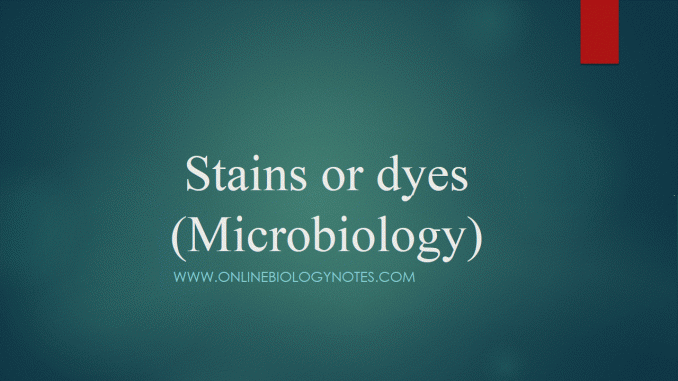
Stains or dyes used in microbiology: Composition, types and mechanism of staining
Composition
- Stain or dye is the synthetic chemical which is derived from nitrobenzene or aniline.
- stains are used commonly in microbiology to increase the contrast between microorganisms or parts of its and the background,so that it can be easily visible.
- The process of giving colour to particular organism or components of its is known as staining.
Each stain or dye is composed of three components.
i) Benzene ring
ii) chromophore
iii) Auxochrome
- Benzene ring is the colourless part of a dye and it is basic structural component of a dye.
- chromophore is the functional group of a dye that give colour to the stain.
- benzene ring and chromophore is collectively known as chromogen.
- auxochrome is the group that gives ionic property to the stain.
Types of stains
Based on the nature of chromogen, there are three types of stain.
1. Acidic stain (Anionic stain)
2. Basic stain (Cationic stain)
3. neutral stain
Acidic stain (Anionic stain)
- Chromogen of acidic stain is negatively charged. so, it is also known as Anionic stain
- Acidic stain are used to stain the positively charged components such as background staining.
- histone protein is positively charged so it can be stained by acidic stain.
- Acidic stain can not stain bacterial cell due to repulsion of same charge.
- Examples: Eosin, Nigrosin, India ink
Basic stain (Cationic stain)
- Chromogen or coloured part of basic stain is positively charged. so, it is also known as cationic stain.
- Basic stain are used to stain negatively charged components such as bacterial cell.
- Examples: methylene blue, safranin, malachite green,basic fuschin, crystal violet
Neutral stain:
- In neutral stain, both caation and anion are coloured, such that net charge is neutral.
- Neutral stain are actually is a salt of acidic and basic stain.
- Examples: giemsa stain.
Mechanism of staining:
- The process of staining involves ion exchange reaction between the stain and component to be stained
- For example, bacterial cell is a negatively charged due to large number of protein having COO- group. This negative charged is balanced by positive charged ion presentoutside the cell wall.
- Therefore a bacterial cell is represented as (BACTERIAL CELL -) Na+.
- To stain the bacterial cell, cationic dye are used having positively charged chromogen. eg. Methylene blue, which is represented as (MB+)Cl-.
- During staining, bacteria cell is flooded with methylene blue and due to ion exchange mechanism acidic component of bacterial ie bacterial cell wall become stained.
- The reaction occurs as follows;
(BACTERIAL CELL-)Na+ + (MB+)Cl- ======NaCl + (BACTERAIL CELL -)MB+
